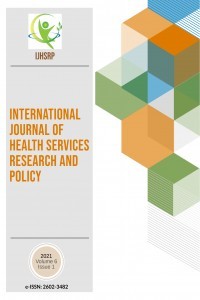HOSPITALIZATION RATES OF PATIENTS USING COMMUNITY MENTAL HEALTH CENTER SERVICES
HOSPITALIZATION RATES OF PATIENTS USING COMMUNITY MENTAL HEALTH CENTER SERVICES
Non-adherence to treatment and hospital admissions are the common problems in severe mental disorders. To determine the contribution of community mental health center (CMHC) services to increased hospitalization rates of patients previously diagnosed with severe mental disorders such as schizophrenia spectrum and other psychotic disorders and bipolar disorders. 356 patients diagnosed with bipolar disorder, schizophrenia, schizoaffective disorder, and unspecified schizophrenia spectrum and other psychotic disorders in accordance with the DSM–5 criteria and treated in the CMHC on the south coast of Turkey were included in this retrospective study.The hospitalization records of the patients were examined over three different periods. First and second period: two divided years which patients had not yet received CMHC services before registration. Third period: one-year, during which patients using CMHC services. A total of 356 patients were included in the study. SPSS 22.0 (IBM Corporation, Armonk, New York, United States) software was used in the analysis of variables. Normal distribution of data was assessed with the Shapiro–Wilk test. The diagnosis of the participants in the study were 157 (44%) schizophrenia, 35 (9.8%) schizoaffective disorder, 102 (28.7%) bipolar disorder and 62 (17.4%) unspecified schizophrenia spectrum and other psychotic disorders. As a result of the hospitalization rates, there was a significant difference between three periods. The median number of hospitalization days during the first episod was calculated as 1.0 (mean 13.9), the second period 0.7 (mean 18.59) and third period 0.6 (mean 5.83), respectively.The rate of hospitalization was 32.9% in the first period, 42.4% in the second period and 12.9% in the third period. This study provides the new evidence regarding the ability of primary services offered in the community mental health centers.
Keywords:
hospitalization, schizophrenia bipolar, psychosis, community mental health,
___
- [1]. Boden, R et al. “Early non-adherence to medication and other risk factors for rehospitalization in schizophrenia and schizoaffective disorder”, Schizophrenia Research,133, 36–41, 2011.
- [2]. MacDonald, L et al., “Improving medication adherence in bipolar disorder: A systematic review and meta-analysis of 30 years of intervention trials”, J Affect Disord,194, 202-221, 2016.
- [3]. Koolmees, AH et al., “Predicting rehospitalization in patients treated with antipsychotics: A prospective observational study”, Ther Adv Psychopharmacol, 8, 213-229. 2018.
- [4]. Shao, WC et al., “The relationship between medication adherence and rehospitalization: A prospective study of schizophrenia patients discharged from psychiatric acute wards”, Hu Li Za Zhi, 60, 31-40, 2013.
- [5]. Guo, X et al., “Effect of antipsychotic medication alone vs combined with psychosocial intervention on outcomes of early-stage schizophrenia: A randomized, 1-year study”, Arch gen psychiatry, 67: 895-904, 2010.
- [6]. Girlanda, F et al., “Guideline implementation strategies for specialist mental healthcare”, Curr Opin Psychiatry, 26, 369–375, 2013.
- [7]. Sin J, Gillard S, Spain D et al., “Effectiveness of psychoeducational interventions for family careers of people with psychosis: A systematic review and meta-analysis”, Clin Psychol Rev,56: 13-24, 2017.
- [8]. Organization WH . The World Health Report: Mental health: new understanding, new hope. World Health Organization. 2001.
- [9]. Ensari, H et al., “The effects of the service of community mental health center on the schizophrenia patients -evaluation of quality of life, disabilities, general and social functioning a summary of one year follow-up”, Anatolian J Psychiatry, 14, 108-214, 2013
- [10]. Aydın, E et al., “Revolving door phenomenon: The effect of application of community-based mental health services model at acute psychiatric hospitalization”, Anatolian J Psychiatry, 15,185-191, 2014.
- [11]. Correll, CU et al., “Comparison of Early Intervention Services vs Treatment as Usual for Early-Phase Psychosis: A Systematic Review, Meta-analysis, and Meta-regression”, JAMA Psychiatry, 1, 555-565, 2018.
- [12]. Ucok, A et al., “One year outcome in first episode schizophrenia: Predictors of relapse”, Eur Arch Psychiatry Clin Neurosci,256, 37–43, 2006
- [13]. Grinshpoon, A et al., “Post-discharge contact with mental health clinics and psychiatric readmission: A 6-month follow-up study”, Isr J Psychiatry Relat Sci,48, 262-267, 2011.
- [14]. Lee, SY et al., “Outpatient Follow-Up Visit after Hospital Discharge Lowers Risk of Rehospitalization in Patients with Schizophrenia: A Nationwide Population-Based Study”, Psychiatry Investig, 12, 425433, 2015.
- [15]. Swain, SP & Behura SS., “A comparative study of quality of life and disability among schizophrenia and obsessive-compulsive disorder patients in remission”, Ind psychiatry J, 25, 210-215, 2016.
- [16]. Haddad, PM et al., “Nonadherence with antipsychotic medication in schizophrenia: Challenges and management strategies”, Patient Relat Outcome Meas, 5, 43-62, 2014.
- [17]. Sims, H et al., “Text message reminders of appointments: A pilot intervention at four community mental health clinics in London”, Psychiatr Serv, 63, 11961-1968, 2012.
- [18]. Schöttle, D et al., “Effectiveness of integrated care including therapeutic assertive community treatment in severe schizophrenia-spectrum and bipolar I disorders: Four-year follow-up of the ACCESS II study”, PLoS One, 13, e0192929, 2018.
- Yayın Aralığı: Yılda 3 Sayı
- Başlangıç: 2016
- Yayıncı: Rojan GÜMÜŞ
Sayıdaki Diğer Makaleler
HOSPITALIZATION RATES OF PATIENTS USING COMMUNITY MENTAL HEALTH CENTER SERVICES
Şengül ŞAHİN, Gülçin ELBOĞA, Abdurrahman ALTİNDAG
HEALTHY LIFESTYLE BEHAVIORS OF STUDENTS AT THE FACULTY OF EDUCATION
Elif IŞIK, Yalçın KANBAY, Özgür ASLAN
HISTOLOGICAL AND HISTOCHEMICAL EVALUATION OF NORMOTENSIVE AND PREECLAMPTIC PLACENTAS
Gamze ERDOGAN, Yusuf NERGİZ, Elif AĞAÇAYAK
Bülent ASMA, Süreyya YİĞİTALP RENÇBER, Sinemis ÇETİN DAĞLI, Ali CEYLAN
Barbara BURMEN, Mevis OMOLLO, George OTİENO
HISTOPATHOLOGICAL CHANGES OF THE UMBILICAL CORD IN COMPLİCATED PREGNANCIES
